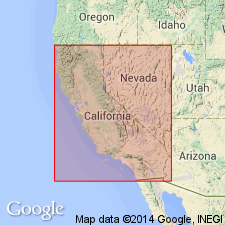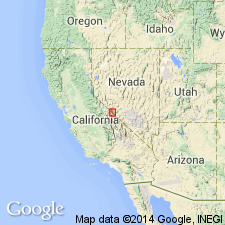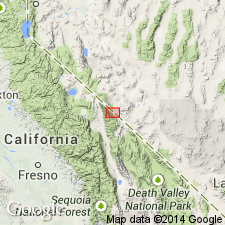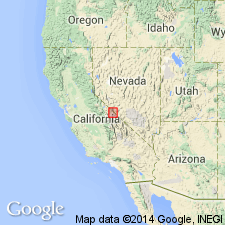
- Usage in publication:
-
- Pellisier granite
- Modifications:
-
- First used
- Dominant lithology:
-
- Granite
- AAPG geologic province:
-
- Sierra Nevada province
Summary:
Batholith which forms core of northern Inyo Range is composed chiefly of two granites which are designated Pellisier and Boundary Peak granites. Pellisier granite is extremely variable in composition and texture; it may be described as hornblende granite with monzonitic tendencies.
Source: GNU records (USGS DDS-6; Menlo GNULEX).

- Usage in publication:
-
- Pellisier granite
- Modifications:
-
- Named
- Dominant lithology:
-
- Granite
- AAPG geologic province:
-
- Sierra Nevada province
Summary:
Pg. 8-11, 73. Named proposed for one of "intrusives" divisible into two units, "Boundary Peak Granite" and "Pellisier Granite." Is variable in composition and texture. Color varies from medium- to dark-gray due to ferromagnesium content and prevailing bluish-gray tint of its quartz and feldspars. Tends to be porphyritic. Geologic sketch map of White Mountain quadrangle shows unit in contact with sedimentary rocks of Cambrian and Precambrian age and in contact with Boundary Peak Granite. On p. 73, "writer believes Pellisier granite was formed IN SITU by granitization of series of early Cambrian or Precambrian sediments and interbedded volcanic rocks." Granites are probably approximately equivalent in age to Sierra batholith --that is, middle or late Mesozoic.
Typically exposed on surface of Pellisier Flats which occupies large area along crest of Inyo Range, White Mountain 30- by 60-min quadrangle, central eastern CA.
Source: GNU records (USGS DDS-6; Menlo GNULEX); US geologic names lexicon (USGS Bull. 1200, p. 2973).

- Usage in publication:
-
- Pellisier Granite
- Modifications:
-
- Not used
- AAPG geologic province:
-
- Sierra Nevada province
Summary:
In present study (Mt. Barcroft 15' quad), Cabin and western part of Barcroft Granodiorites correspond to Pellisier Granite. Pellisier Granite as previously mapped, is indeed a variable rock. "This variation, however, is not due to replacement of pre-existing sedimentary rocks; it can be attributed to separate intrusions, metasedimentary rocks, and contamination of the intrusives by the country rock", p.147. Age of Cabin and Barcroft Granodiorites is Jurassic as shown on geologic sketch map.
Source: GNU records (USGS DDS-6; Menlo GNULEX).

- Usage in publication:
-
- Pellisier Granite
- Modifications:
-
- Not used
- AAPG geologic province:
-
- Sierra Nevada province
Summary:
Term "Pellisier Granite" was first used on geologic map by Anderson (1937) and included rocks on east side of range that Emerson (1966) later found to be separate masses. Terms "quartz monzonite and granite of Pellisier Flats" or "Pellisier Flats" unit (of probably Triassic or Jurassic age) used in this report to avoid confusion with Pellisier Granite of Anderson (1937).
Source: GNU records (USGS DDS-6; Menlo GNULEX).
For more information, please contact Nancy Stamm, Geologic Names Committee Secretary.
Asterisk (*) indicates published by U.S. Geological Survey authors.
"No current usage" (†) implies that a name has been abandoned or has fallen into disuse. Former usage and, if known, replacement name given in parentheses ( ).
Slash (/) indicates name conflicts with nomenclatural guidelines (CSN, 1933; ACSN, 1961, 1970; NACSN, 1983, 2005, 2021). May be explained within brackets ([ ]).

